It was just too much at one time,” Ashton P. Woods remembers.
Woods was already an activist. In the late 1990s, at age 15, he started one of the first Gay-Straight Alliances in his home city of New Orleans. He volunteered and interned with progressive political candidates, advocated for women’s and LGBT rights, and advanced get-out-the-vote efforts in Houston, Texas, where he now lives.
Then Trayvon Martin was murdered, and Michael Brown. Their killers went free. Videos of black people being abused or slain by police began to surface, again and again: Eric Garner. Walter Scott. Sandra Bland.
“It’s different when you know something is happening, to then have there be visual proof,” muses Woods. “It infuriates, and it makes you want justice—what people have been telling you is imaginary and untrue has now been proven to be true.”
Woods marks the shooting death of Michael Brown at the hands of a police officer in Ferguson, Missouri, as the event that connected him to the movement now known as Black Lives Matter.
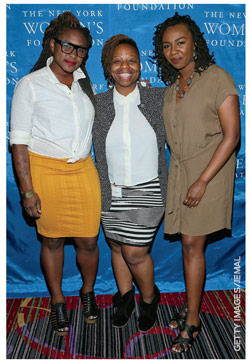 |
| Black Lives Matter co-founders Alicia Garza, Patrisse Cullors and Opal Tometi |
The phrase dates back to 2013, following George Zimmerman’s acquittal for the slaying of Martin, an unarmed 17-year-old. Alicia Garza, one of the three black women who founded #BlackLivesMatter, ended an impassioned love letter to the black community on Facebook with the phrase. Her good friend Patrisse Cullors reposted the message, adding the hashtag. Both seasoned community organizers, the two put their heads together, along with a third friend and sister activist, the digitally savvy Opal Tometi, to create online platforms under that banner.
“Being part of Black Lives Matter fell in my lap, and I felt right at home,” says Woods, who organizes with Black Lives Matter Houston. Woods does not bring HIV into the center of his activism, though he is openly living with the virus. The main goal of his activism is to ensure that people in his community, particularly black LGBT people, are actively engaged in politics and are viewing that work intersectionally.
“One reason I started doing Black Lives Matter work in the context that I do it was that I kept seeing this focus on the bodies of black men,” Woods says. “What about the bodies of black women? Of black trans women? Of black gay folks?”
Black Lives Matter has been called the new civil rights movement. It is unapologetically affirming of queer and trans experiences; two of the network’s three co-founders, Garza and Cullors, identify as queer. Chapters are accountable to the founders and the network; strategic partners across the nation work and speak on the network’s behalf.
There is no traditional, top-down leadership. The movement is what some sources call “leader-full” (as opposed to the “leaderless” model of the Occupy movement that surged, and waned, several years ago).
The target of the Black Lives Matter network is state violence against black people, in all its forms—mass incarceration and over-policing being part of a complex of issues of state involvement in the lives of black people.
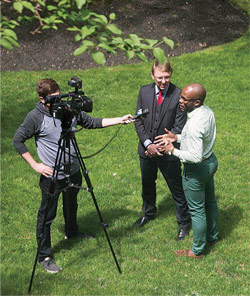 |
| Benjamin Perry and Shawn Torres interviewed in the aftermath of the December 2014 protest |
For Shawn Torres, a youth pastor at St. Luke’s AME Church in Harlem, New York, and a graduate student at Union Theological Seminary, the intent of Black Lives Matter is “to recognize the very specific horrors that come into the lives of black people across the spectrum of what it means to be black; to allow someone like me to raise my voice about HIV activism and have that be realized; to raise up people to speak for their communities and have that be affirmed as part of the work of Black Lives Matter.”
It was Eric Garner’s video-captured death, and a grand jury’s subsequent failure to hold accountable the police officer responsible, that led Torres to take to the streets in protest on a cold, rainy night in December 2014, alongside Benjamin Perry, a Union classmate.
The two men, both in their 20s and alike in virtually every discernible way but their races, were treated very differently when they were both arrested for blocking New York City’s FDR Drive in a peaceful protest: Torres was cuffed, thrown in a police van, stripped of the “weapons” (buttons) pinned to his jacket and refused a phone call; Perry got his call and was allowed to keep identical pins; further, when he offered himself for arrest, the first officer he encountered whispered to him, “Just get out of here.”
The details surrounding their arrests buzzed through mainstream media, from Al-Jazeera to the Melissa Harris-Perry Show to The New York Times. “I think if it had been just me by myself they wouldn’t have believed me,” Torres states. “Because Ben was a white cisgender straight male, and he spoke up alongside me, his word had more power than my word.
“When narratives are told from black people, they aren’t automatically believed to be true,” he adds. “Believing stories of victims is part of the healing process, when we believe the story the first time.”
This illustrates the power of the assertion “Black Lives Matter”—and why “All Lives Matter” will not do. “When we deploy ‘All Lives Matter’ as to correct an intervention specifically created to address anti-blackness,” wrote Black Lives Matter co-founder Garza on Feminist Wire, “we lose the ways in which the state apparatus has built a program of genocide and repression mostly on the backs of black people…and then adapted it to control, murder and profit off of other communities of color and immigrant communities. We perpetuate a level of white supremacist domination by reproducing a tired trope that we are all the same.”
Now, for Torres, Black Lives Matter is a vehicle for heated discussions in his network of churches. “I joined St. Luke’s AME because of their social justice mantra,” he says, “and to use my own experience of being HIV positive to expand the church’s mind beyond social justice for the black male parishioner—[to] the black LGBT parishioner, the black parishioner living with HIV, the black LGBT youth parishioner.”
His own church is affirming, but when he talks about black LGBT identity and HIV in other churches in his denomination, “the energy shifts; people value Black Lives Matter, but many parishioners don’t understand what we mean when we say ‘All Black Lives.’ Everyone doesn’t get on board so quickly.”
As Black Lives Matter co-founder Patrisse Cullors wrote in Essence magazine that the hashtag “arose out of a place of grief and sorrow,” the Black Lives Matter network strives to create spaces for this grief.
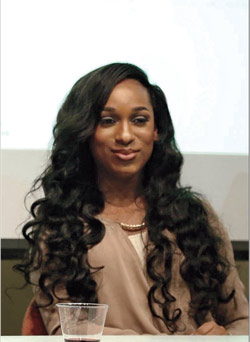 |
| Elle Hearns, a Washington DC-based strategic partner of Black Lives Matter |
“We try to make sure healing is a strategic part of the process, during actions or afterward,” says Elle Hearns, a Washington, DC–based strategic partner of Black Lives Matter. “We constantly have conversations around: What does it look like to name what you’re experiencing, instead of internalizing it? What trauma are you bringing into the spaces where you’re organizing?”
Hearns co-organized Trans Liberation Tuesday, a national day of action on August 25, 2015, called by the Black Lives Matter network to respond to the murders of 18 trans women of color in the United States that year. (As of press time, at least 19 trans women of color had been murdered in 2015.)
“For black trans women,” Hearns explains, “what felt like healing for us was to hear folks who have essentially perpetuated violence take ownership for that.” As part of one event, BuzzFeed reported, black cisgender men and women decried violence against black trans women by naming how they had, in the past, taken part in or ignored such violence.
“Part of healing is discussing what we need to heal from,” Hearns says.
The issues raised by Black Lives Matter activists are not new: They are systemic. According to the Center for American Progress, African Americans are 2.5 times more likely to be arrested than whites, and they face sentences that are an average of 19.5 percent longer than whites’ for similar crimes.
A detailed report by the Malcolm X Grassroots Movement, looking at one year in extrajudicial killings of African Americans in a number of U.S. towns and cities, found that a black man, woman or child was killed by police or vigilantes every 28 hours. A report released in November 2015 by the Black Youth Project found that more than half of black members of the millennial generation, which encompasses people between the ages of 18 and 34, have themselves or know someone who has been the victim of police harassment and violence.
“Increased awareness has not translated into prevention and policy,” Jamil Smith pointed out in The New Republic magazine last year. “The surge of video evidence has only made our society increasingly numb to the spectacle of black death.” A similar claim could be made regarding the underwhelming national response to evidence indicating that black people living with HIV get sicker and die faster than their white counterparts—especially in the Southern United States.
Incidentally, numbing is one of the symptoms of post-traumatic stress disorder (PTSD), which mental health experts in a National Public Radio report explained can result from persistent daily microaggressions and helplessness in the face of violations that are part of the experience of racism in the United States. The American Public Health Association has long called on federal agencies to investigate and eliminate the effects of racism on health outcomes for people of color.
As a growing body of literature attests, violence, trauma and PTSD are all disproportionately experienced by people living with HIV—who are, in the United States, 41 percent black. Nearly mirroring this number is the percentage of the U.S. inmate population that is black: 40 percent, according to 2010 U.S. Census numbers analyzed by the Prison Policy Institute. (Black people make up about 13 percent of the U.S. population.) Research shows that incarceration itself is a form of trauma. Its effects also render people vulnerable to becoming HIV positive.
“Understanding the traumatic impacts of racism and xenophobia” and addressing their effects are essential to providing high-quality care in communities affected by HIV, wrote Naina Khanna of Positive Women’s Network USA (PWN–USA) and Charles Stephens of Counter Narrative Project in an opinion piece. “Racial justice and a commitment to anti-oppressive thinking has to ground our work.”
Kenyon Farrow, a writer and veteran of HIV and criminal justice activism, points out that “trauma is part of the reason it has taken 40-plus years since the end of what we think of as the civil rights movement for black folks to again be fully engaged in broader-based movements.”
Farrow cites the assassinations of key black justice leaders, the ravages of crack cocaine, the war on drugs, massive incarceration and unfathomable losses to complications of HIV as events that “created disruption and confusion in the midst of what we thought would be the thing to really transform this country.
“The legacy of that kind of trauma has not been fully explored,” he says.
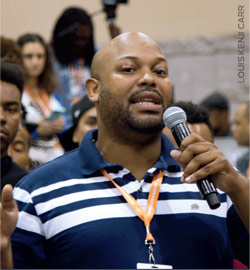 |
| Ashton P. Woods at the Black Lives Matter action targeting Bernie Sanders |
Black Lives Matter activists have engaged in high-profile actions to bring the traumatizing realities of state violence to light. An event that garnered national attention, and considerable criticism, was the interruption of the Presidential Town Hall at the Netroots Nation conference in Arizona in July 2015, featuring Senator Bernie Sanders and former Governor Martin O’Malley.
Both Woods from Houston and Hearns from DC played roles in the action at the progressive gathering. Roughly 100 Black Lives Matter and immigration activists, led by black women, stopped the proceedings to make space for activists to address the candidates about the urgency of the issue of state violence.
Sandra Bland had died in police custody in Texas just a few days earlier. “No one was talking about it; the presidential candidates weren’t talking about it,” Hearns says. Woods had helped organize rallies in Texas following Bland’s death, and he video-taped the Netroots action for his blog. An informal meetup the night before had given activists the opportunity “to build trust, love and understanding of how we were all feeling,” which made space for the plan to come together quickly.
Longtime HIV activist and journalist Michelangelo Signorile was in the Netroots audience; writing about the experience for The Huffington Post, he remarked: “People herald ACT UP for the work it did, but they all seem to forget that in the moment there was enormous tension between the group and the larger progressive community.… Black Lives Matter is doing exactly what it should be doing. And it is getting exactly the response it should be getting, bringing attention in every way possible to an urgent life-and-death issue.”
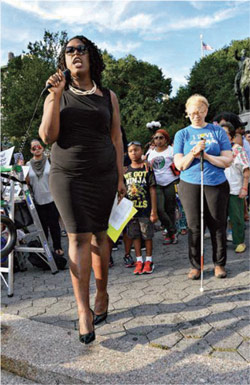 |
| Cherno Biko speaks at a Black Lives Matter rally |
Cherno Biko, a media strategist and Black Lives Matter strategic partner in New York City, credits the example of authentic trans inclusion set by the founders of the movement for why she feels “safer to partner with this iteration of the black liberation movement—because of that intersectionality.”
A lifelong activist (her uncle is anti-apartheid activist Stephen Biko, who died in police custody in South Africa in 1977), Biko lost her brother and a close friend, another black transgender woman, to brutal murders during the same week in 2013. “It’s hard not to take a stand and get more involved when someone in your family is affected by violence on that level,” she says.
She says that she and other black trans women have faced physical and emotional violence at events in the movement, but modeling by the founders ensures that such violence is condemned. “It’s hurt people hurting other people,” Biko explains, referring, like Hearns from DC, to histories of unaddressed trauma that activists often carry.
Valerie Spencer, a social worker who is among the pioneers of transgender activism, began her work in the HIV community in 1992. “There has always been such a marginal telling of our human experience as black trans people: that we are mentally ill, crack addicted, experience high rates of homelessness, joblessness, HIV, family and peer rejection,” Spencer says. “There is much more to be told than just that—there’s a level of contribution by black trans people to movements that has not been discussed.”
Spencer appreciates that, with the advent of Black Lives Matter, “trans advocates who might have been forced to stay in a trans silo have been able to be impactful beyond just an ‘LGBT-friendly’ audience.” Spencer cites an interview on CNN featuring Hearns. “Usually when trans people are present, the conversation shifts to be about the person’s ‘trans-ness,’ even when that’s not the issue,” she says. Hearns “didn’t need to speak about her own trans experience, because assaults on black people, inclusive of black trans people, was the issue at hand.”
“The Black Lives Matter network has created openness in a way we’ve never seen before,” Hearns says. “My hope is that people will be able to see themselves in this work, completely and wholly, outside of just the violence that’s happening—and also that they can see each other.
“That’s the goal of the network,” she adds. “The movement is still trying to catch up with the network, and with a lot of the ideology that the network has gifted to the movement.”
When asked what she knows about HIV criminalization, the response from Biko of New York City is immediate and incisive: “HIV criminalization is just another iteration of state violence against black folks,” she states, adding that the practice is “killing us, literally and figuratively,” by perpetuating stigma and erecting barriers to prevention, testing, care and treatment.
The inaugural Movement for Black Lives Convening, held in Cleveland in July 2015, provided an opportunity to talk about HIV as the social justice issue it has always been, with members of the community that it has always most adversely affected.
Diane Burkholder, a Missouri–based activist who’s worked in HIV and related fields for more than a decade, was among the multigenerational group of activists who came to the convening ready to seize that opportunity. “We’ve been moving this past year in reaction, reaction, reaction,” Burkholder says.
After participating in the Weekend of Resistance in Ferguson in October 2014, Burkholder helped form One Struggle Kansas City to foment solidarity among black and brown communities. The group is exploring becoming a local chapter of Black Lives Matter. “What are the ways we can broaden this conversation to talk about HIV criminalization among black folks?” she says.
The conversations at the convening largely focused on the widely publicized, often sensationalized, case of college wrestler Michael Johnson. That month, Johnson, a young HIV-positive gay black man who’d attended a university just down the road from Ferguson in St. Charles, Missouri, had been sentenced to 30 years in prison for having consensual sex.
Under the antiquated, stigmatizing HIV-related statutes that exist in more than 30 U.S. states and territories—in keeping with national sentencing disparities—a study in AIDS and Behavior suggests black defendants are more likely to be prosecuted and more harshly sentenced than their white counterparts.
Mickyel “Micky” Bradford of Atlanta, who works with several queer and reproductive justice groups including Southerners on New Ground, an LGBT activist organization and a co-sponsor of the convening, aptly calls HIV criminalization “a perfect storm of patriarchal masculinity and anti-blackness.”
Says Waheedah Shabazz-El, longtime activist and regional organizing director of PWN–USA, of the HIV criminalization-themed workshops: “Everything we were giving that audience was new”—from awareness that the state uses HIV status as an additional unjust tool to police and jail black people, to knowledge that there are people of color engaged in HIV activism at all.
“It’s important for folks in the Black Lives Matter movement to know that radical HIV work happens,” Burkholder says. “Once people get the 101, their reaction is: ‘This is BS.’ People were really engaged, and wanted to know how to do more in their communities.”
PWN–USA’s Khanna is also an organizer with Asians4BlackLives, a diverse group of activists of Asian descent working in solidarity and support with the Black Lives Matter movement. “HIV advocates need to be thinking about how anti-black racism plays a role in criminalization, prosecution and sentencing,” she says.
The HIV movement also has lessons to share with Black Lives Matter. Farrow reflects: “A strength of HIV activists is that we have a sense of community organizing strategies; we know a lot about providing services to people who are in desperate need of them; and we understand systems. We have had to come at HIV from so many different angles; we could offer that to movements that are thinking about both how to mobilize people, and what to ask people to mobilize around.”
“The very nature of HIV is intersectional,” Burkholder concludes. “Black Lives Matter is intentional about being intersectional as well. The two go hand-in-hand.”







6 Comments
6 Comments